Related Research Articles

Dolichoderinae is a subfamily of ants, which includes species such as the Argentine ant, the erratic ant, the odorous house ant, and the cone ant. The subfamily presents a great diversity of species throughout the world, distributed in different biogeographic realms, from the Palearctic, Nearctic, Afrotropical region and Malaysia, to the Middle East, Australian, and Neotropical regions.
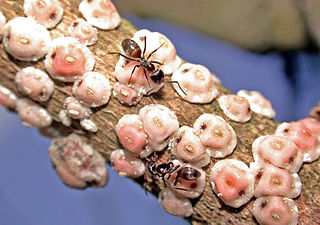
Dorymyrmex is a genus of ants in the subfamily Dolichoderinae.

Monomorium is a genus of ants in the subfamily Myrmicinae. As of 2013 it contains about 396 species. It is distributed around the world, with many species native to the Old World tropics. It is considered to be "one of the more important groups of ants," considering its widespread distribution, its diversity, and its variety of morphological and biological characteristics. It also includes several familiar pest species, such as the pharaoh ant and the flower ant.

Axinidris bidens is a species of ant in the genus Axinidris. Described by Shattuck in 1991, the species is endemic to the Central African Republic, Ghana and Kenya.
Axinidris denticulata is a species of ant in the genus Axinidris. Described by William Morton Wheeler in 1922, the species is endemic to the Democratic Republic of Congo.

Axinidris gabonica is a species of ant in the genus Axinidris. Described by Snelling in 2007, the species is known to inhabit forests in Gabon.
Axinidris hylekoites is a species of ant in the genus Axinidris. Described by Shattuck in 1991, the species is endemic to Ghana, where it was only observed in a rotten tree branch.
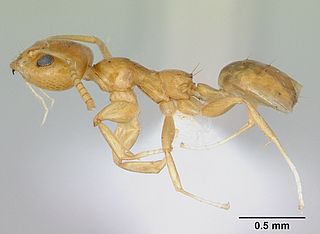
Axinidris hypoclinoides is a species of ant in the genus Axinidris. Described by Santschi in 1919, collected specimens are only known to be from forestry regions in several African countries.
Axinidris icipe is a species of ant in the genus Axinidris. Described by Snelling in 2007, the species is known to be from Kenya.
Axinidris kakamegensis is a species of ant in the genus Axinidris. Described by Shattuck in 1991, the species is endemic to Kenya, where it was only in an unknown area of the Kakamega Forest.
Axinidris hylekoites is a species of ant in the genus Axinidris. Described by Shattuck in 1991, the species is endemic to Nigeria, where it was found alongside a road within some vegetation.
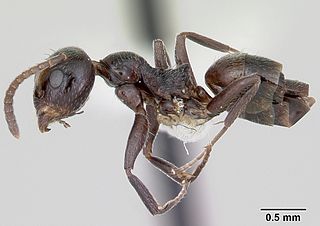
Axinidris lignicola is a species of ant in the genus Axinidris. Described by Snelling in 2007, the species is known to be from South Africa, found in a dead tree trunk.

Axinidris luhya is a species of ant in the genus Axinidris. Described by Snelling in 2007, the species is known to be from Kenya, found on vegetation in forests.
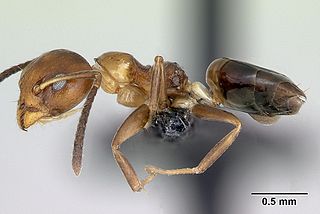
Axinidris mlalu is a species of ant in the genus Axinidris. Described by Snelling in 2007, the species is known to be from the Central African Republic, found on vegetation in rainforests.
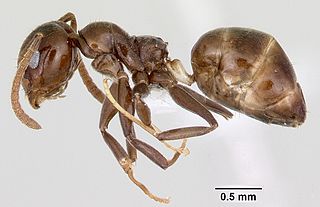
Axinidris murielae is a species of ant in the genus Axinidris. Described by Shattuck in 1991, the species is endemic to several African countries, where they inhabit forests.
Axinidris occidentalis is a species of ant in the genus Axinidris. Described by Shattuck in 1991, the species is endemic to Liberia, and is known to live in habitats that other Axinidris ants prefer.
Axinidris okekai is a species of ant in the genus Axinidris. Described by Snelling in 2007, the species is endemic to Kenya, where specimens have been collected from vines.
Axinidris palligastrion is a species of ant in the genus Axinidris. Described by Shattuck in 1991, the species is endemic to Ghana, where they were found foraging on trees.
Axinidris stageri is a species of ant in the genus Axinidris. Described by Snelling in 2007, the species is endemic to Tanzania.

Neivamyrmex nigrescens is a North American species of army ant in the genus Neivamyrmex. The species is found in the United States and Mexico, and is the most widely distributed Neivamyrmex species in the United States. Due to its wide range, it has become the most studied and well-known species in its genus.
References
- ↑ Snelling, R. R. 2007. A review of the arboreal Afrotropical ant genus Axinidris, pp. 551-579. In Snelling, R. R., B. L. Fisher, and P. S. Ward (eds). Advances in ant systematics (Hymenoptera: Formicidae): homage to E. O. Wilson – 50 years of contributions. Memoirs of the American Entomological Institute, 80.